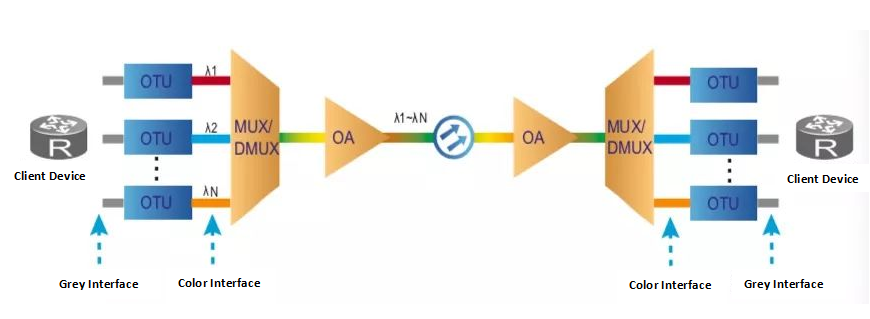Differences Between Grey Transceivers and Color Transceivers

What is a Grey Transceiver?
A grey transceiver is a standard optical transceiver that operates on a single, fixed wavelength without wavelength multiplexing capabilities. The term “grey” is used because these transceivers do not support Wavelength Division Multiplexing (WDM) technology, meaning each signal is treated independently rather than being combined with multiple wavelengths on the same fiber.
Key Characteristics of Grey Transceivers:
1. Fixed Wavelengths: Typically operates at common wavelengths:
- 850nm (for multimode fiber)
- 1310nm (for single-mode fiber, short to medium distance)
- 1550nm (for single-mode fiber, longer distance)
2. No Multiplexing Support: Unlike CWDM or DWDM transceivers (color transceivers), grey transceivers are not designed for combining multiple signals onto a single fiber using different wavelengths.
3. Dedicated Fiber Use: Each grey transceiver requires a dedicated fiber strand for transmission and reception, limiting fiber utilization efficiency compared to WDM systems.
4. Common Applications:
- Point-to-point fiber connections
- Data centers and enterprise networks
- Short-to-long-distance connections that do not require WDM
5. Cost-Effectiveness: Since they do not require complex WDM technology, grey transceivers are generally more affordable than color (CWDM/DWDM) transceivers.
Why Use a Grey Transceiver?
Ideal for standard optical networking where wavelength multiplexing is unnecessary.
Suitable for simple, direct fiber links that do not require expensive WDM infrastructure.
A cost-effective solution for general-purpose optical communications.
What is a Color Transceiver?
A color transceiver is an optical transceiver that operates on a specific wavelength within a Wavelength Division Multiplexing (WDM) system. The term “color” comes from the fact that these transceivers use different wavelengths (or “colors” of light) to allow multiple signals to be transmitted simultaneously over the same fiber, increasing fiber utilization efficiency.
Types of Color Transceivers:
1.CWDM (Coarse Wavelength Division Multiplexing) Transceivers
- Operate on wavelengths ranging from 1270nm to 1610nm, with 20nm spacing.
- Support up to 18 channels on a single fiber.
- Used for short to medium-distance applications (up to ~80km).
- Cost-effective compared to DWDM.
2.DWDM (Dense Wavelength Division Multiplexing) Transceivers
- Operate on tightly spaced wavelengths within 1525nm to 1565nm (C-band) or 1570nm to 1610nm (L-band).
- Support up to 96+ channels on a single fiber.
- Used for long-haul, high-capacity networks (up to hundreds of km).
- Requires precise wavelength tuning and amplification.
Key Characteristics of Color Transceivers:
- Support for WDM Systems: Enables multiple signals to be combined onto a single fiber, reducing the need for additional fiber infrastructure.
- Fixed or Tunable Wavelengths: Some DWDM transceivers are tunable, allowing dynamic wavelength selection.
- Higher Cost than Grey Transceivers: Due to the advanced WDM technology, color transceivers tend to be more expensive.
Common Applications:
- Metro and long-haul optical networks
- Data center interconnects (DCI)
- Carrier networks and ISPs
- 5G fronthaul/backhaul
Why Use a Color Transceiver?
- Maximizes fiber capacity by allowing multiple wavelengths to coexist on a single fiber.
- Ideal for high-bandwidth networks where fiber resources are limited.
- Scalable solution for expanding network capacity without adding more fiber cables.
When to Use Each:
- Grey transceivers are best for standard fiber connections where wavelength multiplexing is unnecessary.
- Color transceivers (CWDM/DWDM) are ideal for expanding network capacity without additional fiber investment.
Grey transceiver and Color transceiver solution
If you want to buy a grey transceiver or color transceiver, Connlight supplies various kinds of grey and color transceivers for your one-stop buying need.
